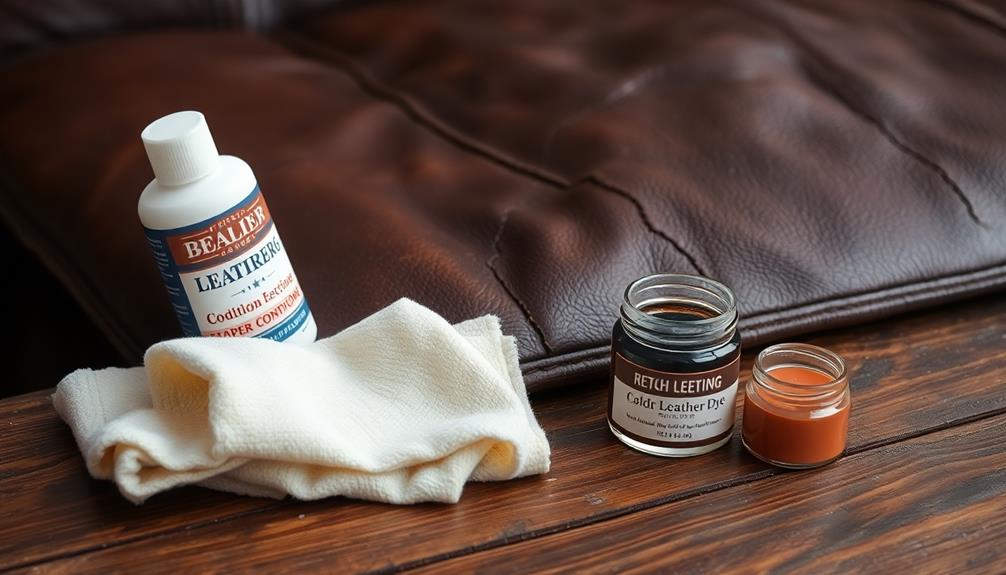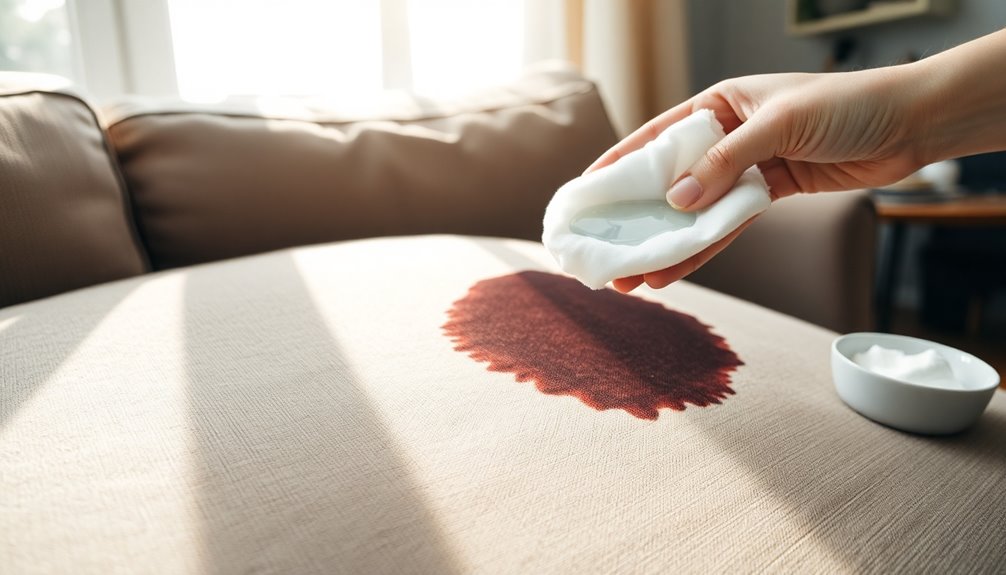You can effectively fix a cracked leather sofa with some simple steps. Start by cleaning the surface with a mild soap solution and allowing it to dry completely. For minor cracks, apply a leather conditioner and let it absorb overnight. If the cracks are deep, use 600-grit sandpaper to smooth the edges, fill them with a leather repair compound, and match the color with dye. Once the repairs are dry, seal them with a quality leather sealer. Regular maintenance, such as conditioning every few months, can help prevent future cracks. Stay tuned for more tips to keep your leather looking great!
Key Takeaways
- Regularly clean and condition leather every three months to prevent and address cracks effectively.
- Assess crack severity and use leather conditioner for light cracks, while deep cracks may require filler.
- Clean the leather surface thoroughly before applying any repair products to ensure proper adhesion.
- Match and apply leather dye to blend repaired areas seamlessly with the original color of the sofa.
- Maintain humidity levels and protect from sunlight to prolong the life of your leather furniture.
Understanding Leather Damage
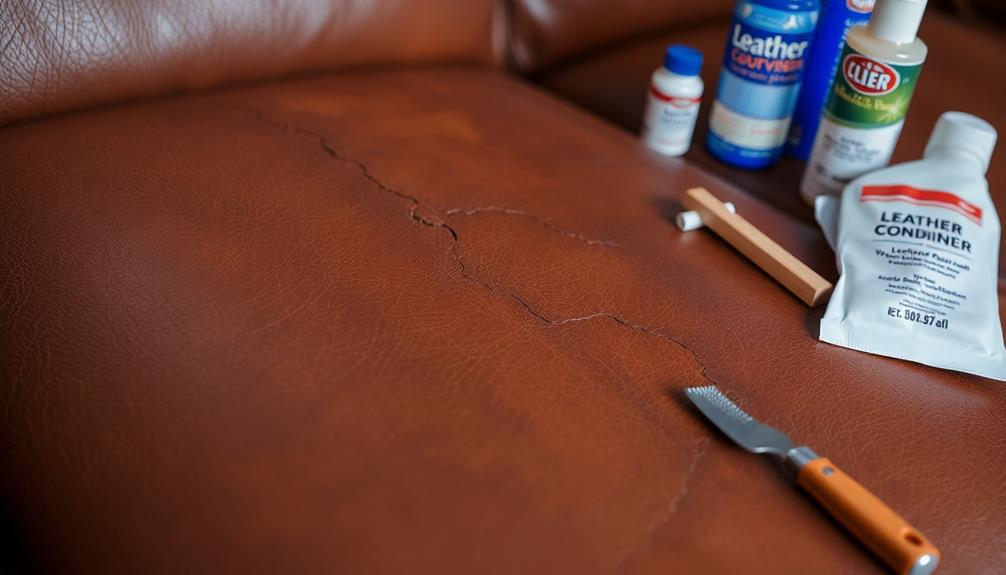
Leather damage can sneak up on you, often starting with subtle signs that you might overlook. As your leather products age, they can lose moisture, leading to dry leather and, ultimately, cracks. These cracks may begin faintly but can worsen without proper attention.
Environmental factors, such as exposure to direct sunlight and extreme temperatures, can accelerate the process, causing your leather to become brittle and worn. Regular care is essential to maintain leather, much like how cold medications require proper selection for effective relief.
To keep your leather in good condition, regular maintenance is essential. You should clean and condition your leather every three months to maintain its moisture levels. Using a high-quality conditioner not only helps to restore lost oils but also prevents future cracks from developing. Remember, the key to repairing cracked leather lies in proactive care. By addressing the signs of damage early, you can prolong the life of your leather sofa.
Neglecting your leather care routine can lead to significant, visible damage, making it harder to repair cracked leather down the line. Stay vigilant and prioritize the upkeep of your leather to enjoy its beauty and functionality for years to come.
Assessing Crack Severity
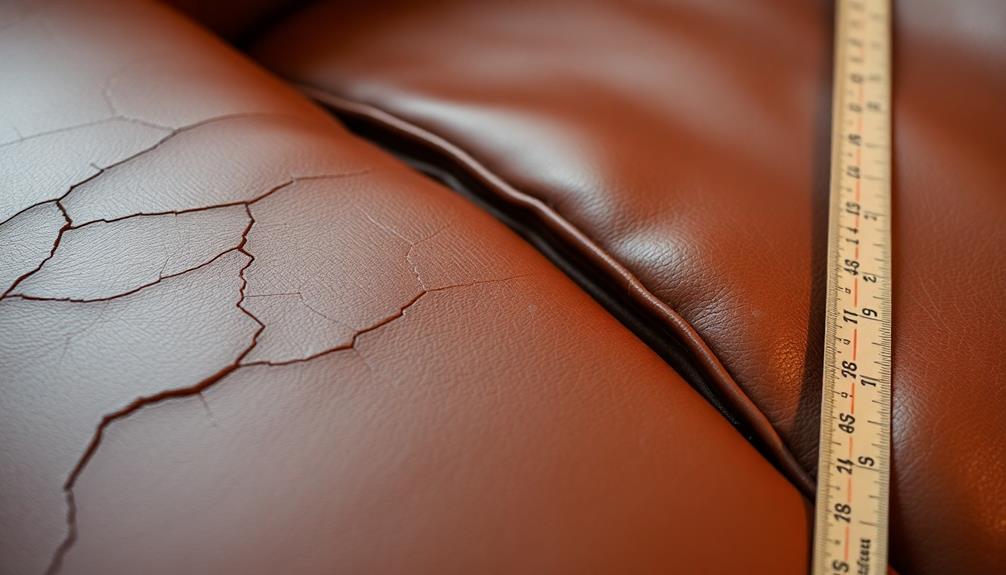
When evaluating the severity of cracks in your leather sofa, start with a careful visual inspection. You'll want to categorize the cracks into two main types: light surface cracks and deep cracks.
Light surface cracks are usually shallow and cosmetic, making them easier to handle. You can often treat these effectively with a high-quality leather conditioner. Additionally, maintaining the environment around your sofa can help prevent future damage, much like how regular maintenance of air purifiers guarantees their efficiency.
On the other hand, deep cracks penetrate through the leather and may require more intensive cracked leather repair methods, such as leather crack filler or glue.
As you assess crack severity, check for additional signs of damage like chafing or stiffness. These could indicate a need for thorough maintenance beyond just addressing the cracks.
For deep cracks, use 600-grit sandpaper to gently smooth the edges, preparing the surface for filler application. This guarantees a better bond and finish, enhancing the overall repair.
Make it a habit to conduct regular assessments of your leather sofa. Catching early signs of cracking allows for timely interventions, preventing further deterioration and guaranteeing your sofa remains in great condition for years to come.
Cleaning the Leather Surface
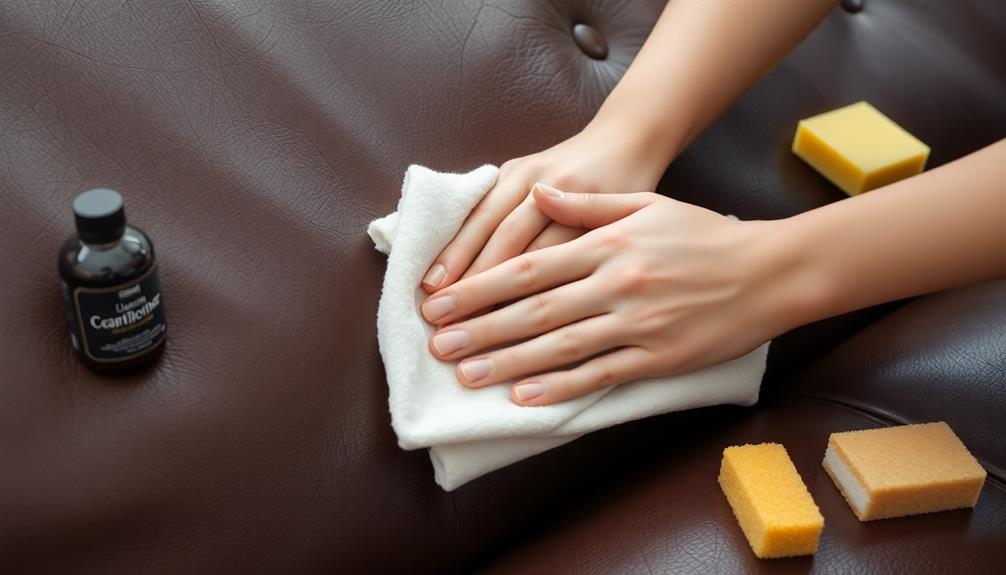
After evaluating the severity of the cracks, it's important to clean the leather surface to prepare it for repair. Regular cleaning maintenance can prevent further damage and extend the life of your leather furniture, similar to how best vacuums for dust removal help maintain a clean environment.
Start by using a soft brush or a microfiber cloth to gently remove dust and debris from the leather surface. This step is essential to guarantee you don't trap any particles during cleaning.
Next, prepare a mild soap solution by mixing a few drops of saddle soap or a specialty leather cleaner with distilled water. Lightly dampen a microfiber cloth with this solution—make sure it's not soaking wet to prevent excess water exposure to the leather.
Now, it's time to wipe the leather. Work in small sections and apply gentle pressure as you clean, making sure you don't cause further damage to the material. This method will help lift grime without harming the leather.
After you've finished cleaning, allow the leather to dry completely overnight in a well-ventilated area. This drying process is essential before proceeding with any conditioning or repair treatments.
Taking these steps will set a solid foundation for your leather sofa restoration.
Repairing Light Cracks
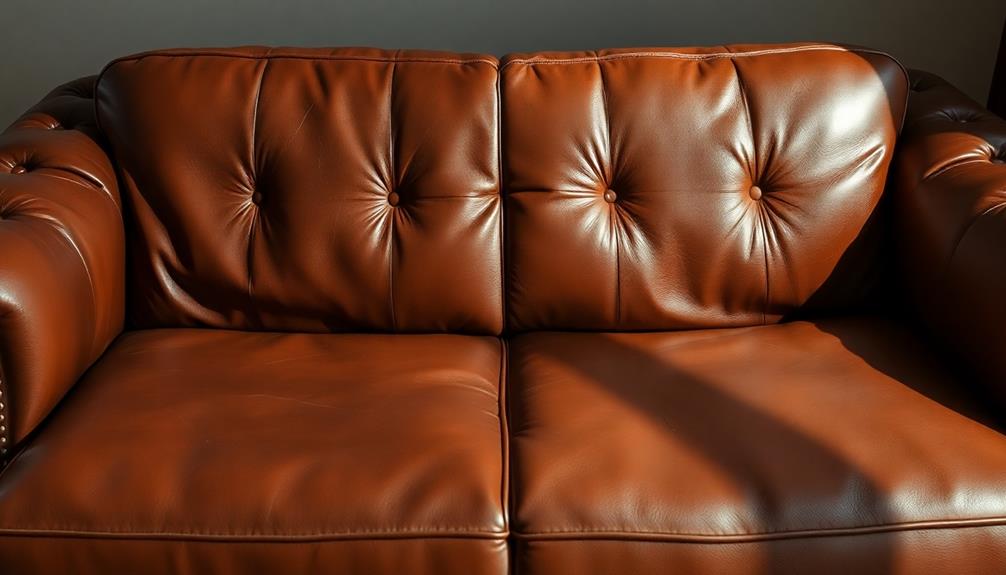
To effectively repair light cracks in your sofa, you'll want to start by cleaning the affected area with a soft brush and a mild soap solution. This step removes dirt and debris, preparing the surface for further treatment.
Once clean, take a clean microfiber towel to dry the area gently. For added moisture and protection, you might consider applying a few drops of essential oils for leather care to enhance the conditioning process.
Next, apply a leather conditioner to rehydrate the leather fibers and smooth out the cracked surface. Focus the conditioner on the cracks, using gentle circular motions to guarantee thorough absorption. It's important to allow it to dry naturally, preferably overnight, to achieve the best results.
If any cracks remain visible after conditioning, you might consider using a leather crack filler. This product can help further smooth the surface and blend with the surrounding leather.
Remember, regular monthly applications of leather conditioner can prevent future cracking and maintain the sofa's appearance and flexibility, so don't skip this crucial step.
Repairing Deep Cracks

When you notice deep cracks in your leather sofa, it's crucial to assess their depth before starting the repair. Understanding the severity of the cracks helps you choose the right filler and apply it effectively.
Additionally, maintaining your leather sofa through regular cleaning and conditioning can prevent future damage, ensuring its longevity. Consider financial mistakes to avoid when budgeting for home repairs to keep your expenses in check.
Let's explore the best techniques for applying the filler to achieve a seamless finish.
Assessing Crack Depth
Evaluating the depth of cracks in your leather sofa is vital for determining the right repair approach. Start by inspecting the surface closely to assess whether the cracks are merely superficial or if they penetrate deeply into the leather. Superficial cracks typically require a simple cleaning and application of conditioner, while deep cracks call for more intensive repair methods involving filler.
It's significant to acknowledge that maintaining your leather furniture is similar to providing proper care for pets, as both require attention to detail to prevent further damage proper diet for pets.
Before you begin any repairs, make sure to clean the leather thoroughly. Dirt and oils can inhibit the effectiveness of fillers and conditioners, leading to unsatisfactory results.
Once you've cleaned the area, focus on the depth of the cracks. If you find deep cracks, gently smooth the edges using 600-grit sandpaper. This step is vital for ensuring better adhesion of the filler, which will help achieve a seamless finish.
Keep in mind that deep cracks may expand if left untreated, so early assessment and intervention can prevent further deterioration of your leather sofa. By accurately determining the depth of each crack, you'll be better prepared to choose the appropriate repair techniques, ensuring your sofa remains in good condition for years to come.
Filler Application Techniques
Once you've assessed the depth of the cracks in your leather sofa and prepared the surface, it's time to tackle the filling process.
Start by cleaning the leather thoroughly to remove any dirt or oils that could hinder adhesion. For an effective cleaning solution, consider using home remedies for cleaning that are non-toxic and safe for leather.
Next, use 600-grit sandpaper to smooth the cracked areas, creating a better surface for the filler.
Now, grab a high-quality leather crack filler and a palette knife. Apply the filler into the cracks, working it in well, and remove any excess to guarantee a smooth finish.
It's essential to allow the filler to dry completely—this usually takes at least six hours in a well-ventilated area to make sure it cures properly.
After the filler has dried, you may need to lightly sand the area again with fine sandpaper to blend it seamlessly with the surrounding leather.
For best results, consider applying a leather dye over the filled cracks to match the original color.
Finally, seal the repair with a leather sealer to protect against future damage and keep your sofa looking great. Allow the sealer to dry completely, ensuring a durable and long-lasting finish. For added protection, you can also consider applying a conditioner specifically designed for leather to keep it soft and supple. Additionally, if you’re looking to fix broken wicker furniture, similar care and attention to proper materials and techniques can help extend the life of those pieces as well.
These filler application techniques will help restore your leather sofa's beauty and durability.
Surface Preparation Techniques

To effectively prepare the leather surface for repair, you should always start by thoroughly cleaning it. Use a specialized leather cleaner or a mild soap solution to remove dirt and oils that could interfere with the repair process.
Before applying any repair products, grab a dry brush or a microfiber cloth to gently wipe away debris, guaranteeing a clean surface for treatment. Additionally, maintaining the leather regularly can prolong its lifespan, similar to how preventive maintenance can extend appliance lifespan considerably.
Next, lightly dampen a microfiber cloth to clean the leather without oversaturating it. Remember, excessive water exposure can lead to further damage. Allow the leather to dry completely overnight; this guarantees a proper bond during the repair.
While waiting, inspect the leather for any deep cracks. If you spot them, you'll want to sand those areas with 600-grit sandpaper to create a smooth surface for filler application.
This step is vital, as a well-prepared surface will lead to better results when you apply the filler and leather conditioner later on. By following these surface preparation techniques, you'll set yourself up for a successful leather repair project.
Applying Leather Dye
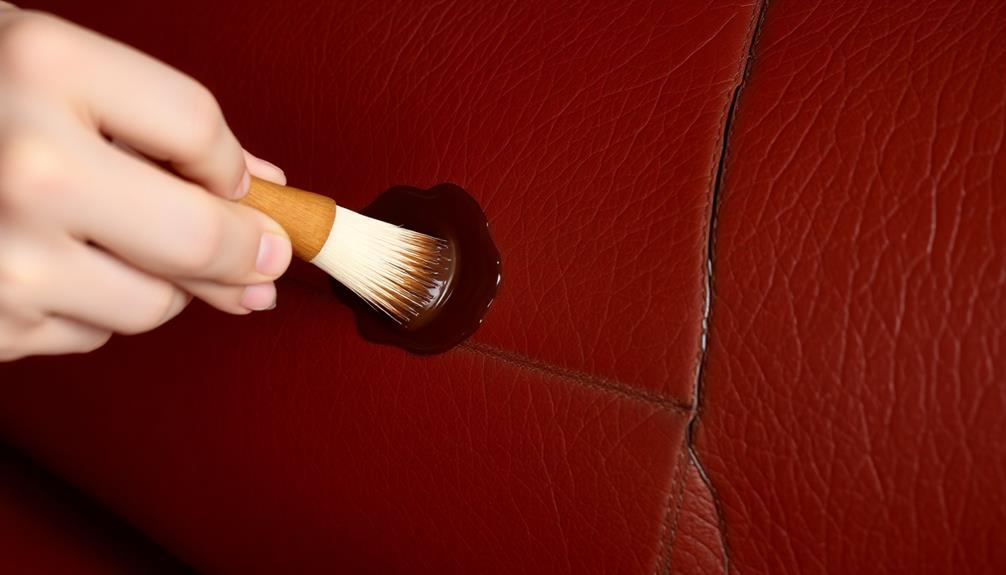
When you're ready to apply leather dye, selecting a shade that closely matches your sofa's original color is vital for achieving a seamless repair. Start by applying a thin coat of dye over the cracked areas using an applicator pad or color-fast sponge. This technique promotes even absorption without pooling, guaranteeing a smooth finish.
| Step | Action | Tips |
|---|---|---|
| 1 | Choose the right leather dye | Match it closely to your sofa's original color. |
| 2 | Apply dye | Use a thin coat and an applicator pad to prevent excess. |
| 3 | Blend deeper cracks | Dab dye directly into fissures and rub the surrounding area. |
As you apply the dye, utilize a hairdryer on a low setting to dry each coat for about two minutes. Be cautious not to overheat, as this can damage the leather. Repeat the blending process until you achieve your desired color and coverage. After this, you'll want to seal the dyed areas to guarantee protection and durability against future damage. This step is vital for maintaining your sofa's appearance and longevity!
Sealing and Protecting Repairs

Now that you've dyed the repaired cracks, it's essential to seal and protect those areas. Choosing the right leather sealer and applying it correctly will help maintain the integrity of your repairs and prevent future damage.
Additionally, just like the importance of regular maintenance for heat pumps to guarantee longevity and efficiency, regular upkeep of your leather sofa is key.
energy-saving features can also apply to your home furniture care, helping you avoid costly repairs down the line.
Let's explore effective sealing techniques and product options.
Leather Sealing Techniques
How can you guarantee your repaired leather sofa stays protected from future damage? After you've addressed the cracks, it's vital to apply a quality leather sealer to the treated areas. This step enhances durability and protects against further wear.
Using a clean sponge or applicator pad, distribute the sealer evenly over the repaired surfaces to guarantee thorough coverage. Additionally, consider using a vacuum cleaner designed for pet hair removal, as high suction power vacuums can help maintain the overall cleanliness of your sofa.
Once applied, you'll want to cure the sealant. A hairdryer on a low setting for about two minutes works wonders, helping to lock in protection and prevent stains from setting in. Depending on the condition of your sofa, you may find that multiple coats of sealer are necessary. Allow each coat to dry completely before applying the next for best results.
For ongoing maintenance, it's important to regularly reapply the leather sealer every few months. This keeps the protective barrier intact and guarantees your leather remains in good condition over time.
Choosing Protective Products
Selecting the right protective products is essential for maintaining the integrity of your leather sofa after repairs. After you've taken the time to repair cracks, applying a high-quality leather sealer is critical. This sealer not only protects the repaired areas but also enhances durability against stains and damage.
Make certain the leather sealer is compatible with the dye and filler you used for repairs, guaranteeing a seamless finish. When applying the sealer, spray it onto a sponge and rub it into the affected areas, assuring even coverage. This step is important for protecting the leather effectively.
To expedite drying, use a hairdryer on low for about two minutes, helping the sealer cure properly. Regular application of the leather sealer every few months can greatly prolong the life of your sofa and maintain its appearance, especially in high-use areas.
Don't forget to use a leather conditioner periodically, as it helps keep the leather supple and further protects against potential damage. By choosing the right protective products and following these steps, you'll make sure your leather sofa stays looking great for years to come.
Maintenance After Repair
After applying protective products, it's important to focus on maintaining your leather sofa to guarantee the repairs hold up over time.
Start by applying a leather sealer to the repaired areas. This will protect your repairs and enhance durability, preventing future damage. Use a clean sponge or applicator pad to evenly distribute the sealer, making sure of complete coverage.
Once applied, cure the sealer by using a hairdryer on low heat for two minutes. This step helps the product penetrate and bond effectively with the leather.
Regular maintenance is vital, so make it a habit to inspect the sealer every six months. If you notice any wear, reapply the leather sealer to maintain protection against stains and everyday use.
Additionally, store your sofa in a cool, dry place away from direct sunlight and heat sources. This will extend the life of your repairs and prevent future cracking.
By taking these steps, you'll make certain your leather sofa remains beautiful and functional for years to come, keeping your hard work in great shape.
Preventative Care for Leather
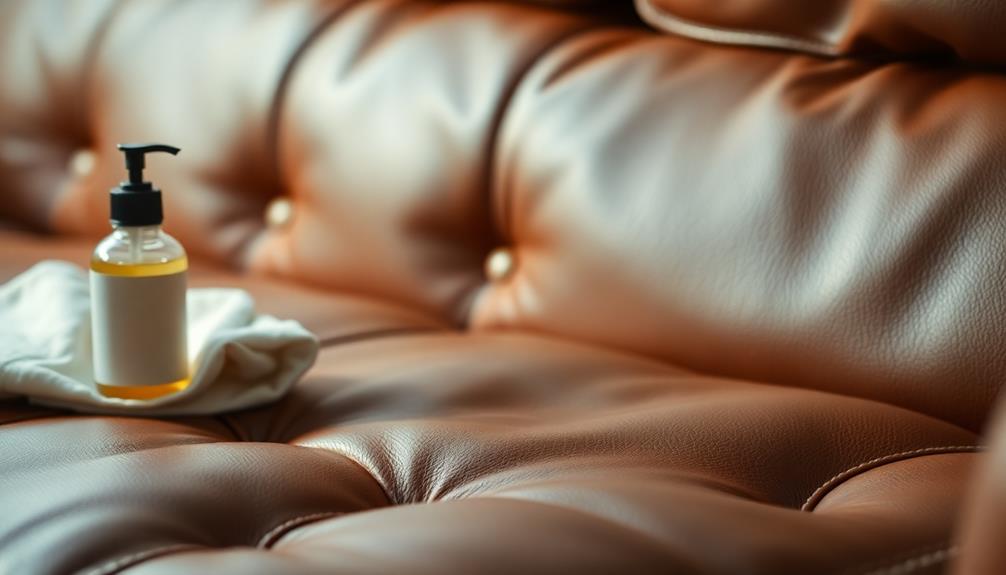
To keep your leather sofa looking its best, regular preventative care is essential.
By following these simple steps, you can maintain the integrity of your leather and prevent drying or cracking.
- Apply a high-quality leather conditioner every three months for moisture replenishment.
- Avoid placing your sofa near direct heat sources or sunlight to prevent accelerated drying.
- Store leather items in an environment with controlled humidity levels, ideally between 40-60%.
- Conduct regular inspections to catch early signs of cracking, allowing for timely preventative measures.
- Invest in protective sprays designed for leather to repel water and stains.
Frequently Asked Questions
Can You Repair a Cracked Leather Couch?
Yes, you can repair a cracked leather couch. Start by applying a quality leather conditioner to hydrate the surface. For deeper cracks, use a filler and dye that matches the original color for seamless results.
How Do You Fix a Split Leather Couch?
To fix a split leather couch, you'll first clean the area, then apply a matching leather crack filler. After it dries, sand lightly, dye the repair, and seal it for lasting protection.
Why Is the Leather on My Sofa Cracking?
Did you know about 90% of leather sofa cracking results from neglecting maintenance? Your sofa's leather might be cracking due to drying oils, environmental factors, or simply its age, leading to brittleness and visible fractures.
How Do You Fix Cracked Peeling Leather?
To fix cracked peeling leather, start by cleaning it thoroughly. Then, apply a quality conditioner to hydrate it. For deeper cracks, use a filler, sand it smooth, dye it, and seal the area for protection.
Conclusion
In the end, breathing new life into your cracked leather sofa isn't just about repairs; it's about cherishing the memories woven into its fabric. With a little care and effort, you can restore its beauty and comfort, allowing it to continue being a beloved part of your home. Embrace the journey of revitalization, and let your sofa once again become a cherished gathering place for laughter, stories, and warmth, just as it was meant to be.
